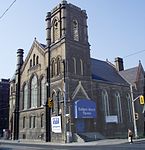Shaarei Tzedec
Shaarei Tzedec Congregation (also known as the Markham Street Shul) is an Orthodox Jewish synagogue located at 397 Markham Street in Toronto, Ontario, Canada. The Shaarei Tzedec congregation was founded in 1902 and is the westernmost of the three Orthodox synagogues left in Downtown Toronto. In 1912, a number of families left Shaarei Tzedec, then on Centre Street, in a dispute over burial rites, and formed a new congregation, Chevra Rodfei Sholem, commonly known as the Kiever Shul.Shaarei Tzedec has been located in a converted Victorian semi-detached house on Markham Street, near Bathurst Street and College Street, since 1937. The Markham Street Shul is one of the few remaining synagogues and the last remaining shtiebel of what were once dozens of small congregations in the area around Kensington Market, Spadina Avenue and Bathurst Street - which was a vibrant Jewish area prior to World War II.
Excerpt from the Wikipedia article Shaarei Tzedec (License: CC BY-SA 3.0, Authors).Shaarei Tzedec
Markham Street, Toronto
Geographical coordinates (GPS) Address Phone number Website External links Nearby Places Show on map
Geographical coordinates (GPS)
| Latitude | Longitude |
|---|---|
| N 43.65947 ° | E -79.4099 ° |
Address
Congregation Shaarei Tzedec
Markham Street 397
M6G 1A1 Toronto
Ontario, Canada
Open on Google Maps










